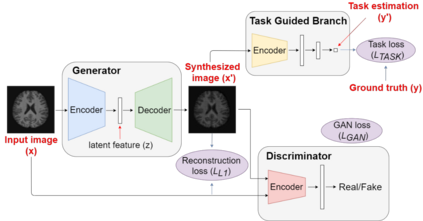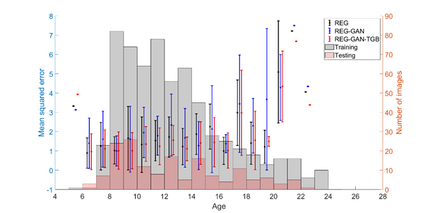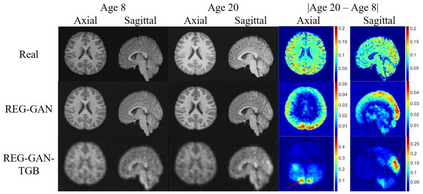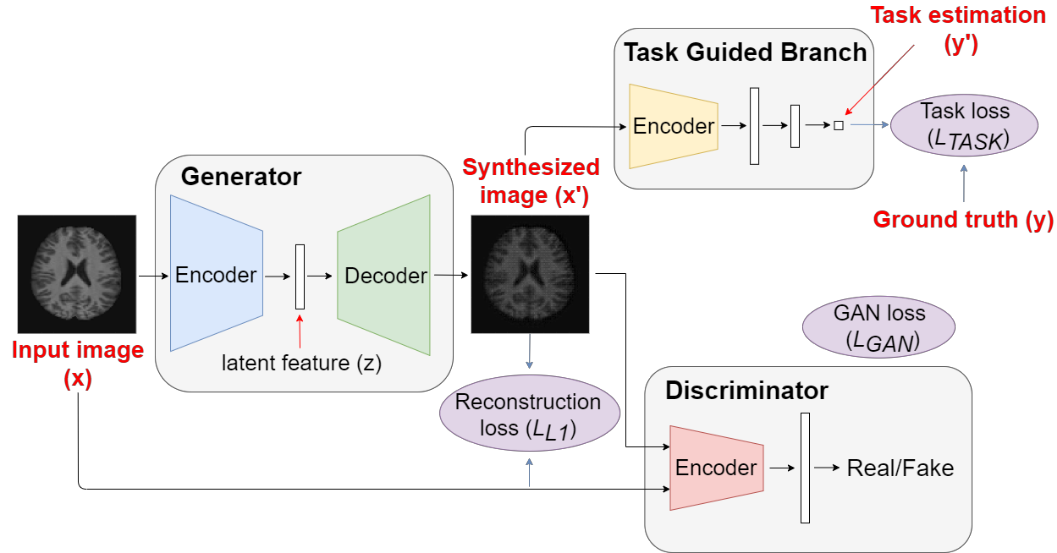Brain age estimation based on magnetic resonance imaging (MRI) is an active research area in early diagnosis of some neurodegenerative diseases (e.g. Alzheimer, Parkinson, Huntington, etc.) for elderly people or brain underdevelopment for the young group. Deep learning methods have achieved the state-of-the-art performance in many medical image analysis tasks, including brain age estimation. However, the performance and generalisability of the deep learning model are highly dependent on the quantity and quality of the training data set. Both collecting and annotating brain MRI data are extremely time-consuming. In this paper, to overcome the data scarcity problem, we propose a generative adversarial network (GAN) based image synthesis method. Different from the existing GAN-based methods, we integrate a task-guided branch (a regression model for age estimation) to the end of the generator in GAN. By adding a task-guided loss to the conventional GAN loss, the learned low-dimensional latent space and the synthesised images are more task-specific. It helps to boost the performance of the down-stream task by combining the synthesised images and real images for model training. The proposed method was evaluated on a public brain MRI data set for age estimation. Our proposed method outperformed (statistically significant) a deep convolutional neural network based regression model and the GAN-based image synthesis method without the task-guided branch. More importantly, it enables the identification of age-related brain regions in the image space. The code is available on GitHub (https://github.com/ruizhe-l/tgb-gan).
翻译:基于磁共振成像(MRI)的深层学习方法在许多医学图像分析任务(包括大脑年龄估计)中达到了最先进的性能。然而,深层学习模型的性能和可概括性高度取决于培训数据集的数量和质量。无论是收集还是注意到大脑MRI数据都非常耗时。在本文中,为了克服数据稀缺问题,我们提议采用基于图像合成的对抗网络(GAN)图像合成方法。不同于现有的基于GAN的图像合成方法,我们将任务指导分支(年龄估计的回归模型)并入GAN的发电机末端。通过增加基于常规GAN损失、学习的低度潜伏空间和综合现有图像的任务引导损失,它更需要时间。通过整合基于数据稀缺的图像合成系统(GAN),我们提议了一个基于图像合成系统/内基综合图像的下游工作,通过整合基于GAN的直位图像和真实年龄分析方法,将一个任务指导分支的GAN 。我们提出的基于模型的模型模型模型-系统化方法的模型-模型-模型-模型-模型-模型-模型-模型-模型-系统化的模型-模型-系统-模型-模型-系统模型-系统化的模型-模型-模型-模型-模型-模型-模型-模型-模型-模型-模型-模型-模型-模型-模型-模型-模型-模型-模型-模型-模型-模型-模型-模型-模型-模型-模型-模型-模型-模型-模型-模型-模型-模型-模型-模型-模型-模型-模型-模型-模型-模型-模型-模型-模型-模型-模型-模型-模型-模型-模型-模型-模型-模型-模型-模型-模型-模型-模型-模型-模型-模型-模型-模型-模型-模型-模型-模型-模型-模型-模型-模型-模型-模型-模型-模型-模型-模型-模型-模型-模型-模型-模型-模型-模型-模型-模型-模型-模型-模型-模型-模型-模型-模型-模型-模型-模型-模型-模型-模型-模型-模型-模型-模型-模型-模型-模型-模型-模型-模型-模型-模型-模型-模型-模型-模型-模型-模型-模型-模型-模型-模型-模型-模型-模型-模型-模型








